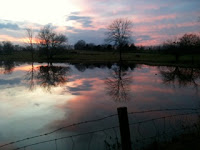January’s entrance has been typical to form with days of high humidity and sultry warm, followed by storms which bring rain and cold winds. It is an amazing thing that anyone living in this ridiculously fickle climate doesn’t stay perpetually ill, but it is with this volatile weather pattern that there comes a beauty to my world that doesn’t come any other time of year, especially in the late afternoons of these early winter days.
January is a study of blues. The range of hues within the realm of what we think of as blue is almost an endless parade of variations on the theme. Today is a cold clear wash of pure cobalt, cloudless and seamless. The past week, though, was hung with an occluded front which brought a continual trail of moisture from the Gulf of Mexico, and with it came many clouds of varying sizes and shapes, and also at varying altitudes. This moisture and its clouds then brought out other tubes of color to mix with this background base of cobalt.
The heaviest of these clouds were a deep periwinkle sometimes topped with an icing of bright white. This periwinkle is a cobalt mixed with a deep burnt umber and a slight touch of rose madder. They drifted by, brooding and ominous. There were some that were mixed with cerulean, some of Prussian blue, and some with ultramarine, all rich and lovely, a perpetual watercolorist’s dream sky all day long. It has been the afternoons though this past week which have been almost boring in their predictable repetition of amazing beauty, a wild explosion of color and drama to the fading sunsets.
We live on a small, barely two lane, barely paved, dead end rural road which hits the county road at its beginning. At this beginning is our neighbors‘ cow farm. It is a large farm with many paddocks and large fields dotted with cows of different colors, mostly all black, and as with most cow farms there are ponds for them to drink from and stand in during the hot summer months. Since cows don’t sweat they need these refuges to chill out in and take in hydration and the little ponds fill both jobs. There is such a pond on the west side of our little road, just after one turns from the county highway onto our road.
By being on the west side of the road, this pond unwittingly lends itself to some of the most spectacular sunsets I have ever seen or could have imagined. An ugly cow pond by day, in the late sinking sunsets of January, this pond turns into a magic array of colors one can not believe unless one sees it first hand, or sees Mark’s photographs of it which truly and accurately mirror this phenomenon. My simple cell phone shots do no justice to it at all. When the sun finally gets almost below the cloud cover on the distant horizon is when it all starts.
There is a sudden blast of surreal color as the warm beams of the casting sunlight hit the undersides of these floating periwinkle clouds, and they burst into flames of oranges and pinks that scream against the backdrop of the vast arrays of blue hues surrounding them.
The winter grasses on the opposite side of the pond are equally extreme with shades of electric chartreuse that are divided by the vertical stands of the bare black trees whose limbs reach wide into this sky on fire above them.
There are usually a few black cows grazing on the lush winter pasture on the slow rise of the hill behind the pond, just to finish off this scene. The heifers are now in calving season and are steadily dropping small calves and these babies lay on the chartreuse blanket like a scattering of black confetti. The scene is both equally bucolic and serene, and dramatically surreal.
Mark has beautifully and masterfully photographed this reoccurring scene for several seasons now and each photograph from each changing sunset is widely different in mood, but each still retains a continuing prominent theme.
There is always, the pond. It is in its quiet reflective nature that makes the gift of this scene and, that is the kiss on the photograph. It is in the mercurial silver mirror of its still water that one gets to see the blaze in the sky twice, a perfect equal reflection of the blues, pinks, and oranges, until the big orb slides below the horizon and the scene turns back to blue, then fades to black.
Today, as I said earlier, the sky is a dome of an unmarred cobalt wash. There is not going to be a dramatic sky over the pond this afternoon so we will have wait for another one when the next frontal system slides into our area and pulls up more humidity from the south. Clear skies of January have their own magic too though. Theirs’ is the revelation of the stars and planets that grace the cold black nights. No longer obscured by the passing moisture and clouds, Orion rises early and stays late followed closely by a sparkling Sirius, the Dog star and brightest star in the sky. Together always they rise and fall across the ecliptic of the winter nights, shining, twinkling, and hang there as reliable markers of the, once more, changing seasons around us.
Below is just one of the many gifts that Mark has captured, with his amazing gift of catching light
 |





nice
ReplyDeletenice
ReplyDelete